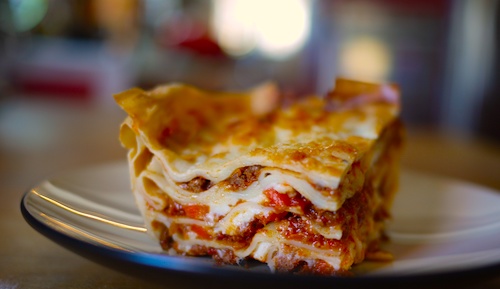This is the magical lasagna recipe from the 1967 edition of “The Cooking of Italy.” The book is long out of print, but I found a scan of the recipe online. The original recipe calls for twice as many chicken livers, which was too much for my taste, but either way, this is the most amazing lasagne you will ever eat.
Lasagne Pasticciate
Serves 6 to 8
For the Ragu Bolognese
To make about 2-1/2 cups
1/4 pound prosciutto, coarsely chopped (about 1 cup)
1 cup coarsely chopped onions
1/4 cup coarsely chopped carrots
1/2 cup coarsely chopped celery
4 tablespoons butter
2 tablespoons olive oil
3/4 pound round steak, ground twice
1/4 pound lean pork, ground twice
1/2 cup dry white wine
2 cups beef stock, fresh or canned
2 tablespoons tomato paste
1/4 pound chicken livers
Pinch of ground nutmeg
Salt
Freshly ground black pepper
For the Lasagne
6 to 8 quarts water
1 tablespoon salt
1/2 pound Barilla oven-ready lasagne noodles
For the Besciamella
3 tablespoons butter
6 tablespoons flour
2 cups milk
1 cup heavy cream
Pinch of ground nutmeg
1 teaspoon salt
2 1/2 cups ragu bolognese
1/2 cup freshly grated imported Parmesan cheese
Make the Ragu Bolognese
Combine the chopped prosciutto, onions, carrots and celery on a cutting board, and chop them together into very small pieces. (This mixture is called a battuto, which when cooked becomes a soffritto.)
Melt 2 tablespoons of the butter over moderate heat in a heavy, 10- to 12-inch skillet. When the foam subsides, add the battuto and cook, stirring frequently, for about 10 minutes, or until it is lightly browned. With a rubber spatula, transfer the soffritto to a heavy 3- to 4-quart saucepan. Heat 2 tablespoons of olive oil in the same skillet, and in it lightly brown the ground round steak and pork over moderate heat, stirring the meat constantly to break up any lumps. Then pour in the wine, increase the heat, and boil briskly, still stirring constantly, until almost all of the liquid in the skillet has cooked away. Add the meat to the soffritto in the saucepan, and stir in the stock and tomato paste. Bring to a boil over high heat, then reduce the heat and simmer, partially covered, for 45 minutes, stirring occasionally.
Meanwhile, over high heat melt 2 more tablespoons of butter in the original skillet, and when the foam subsides, add the chicken livers. Cook them for 3 or 4 minutes, or until they are firm and lightly browned. Chop the chicken livers into small dice, set them aside, and add them to the sauce 10 minutes before it is done.
Cook the Lasagne Noodles
In a large soup pot or kettle, bring the water and salt to a bubbling boil over high heat. Add the lasagne, stirring gently for a few moments with a wooden fork to be sure the strips do not stick to one another. Boil over high heat, stirring occasionally, until the lasagne is tender, but still al dente-the time may vary between 10 and 25 minutes, depending on whether you use homemade or commercial lasagne. Set the pot under cold running water for a few moments to cool the pasta. Then lift out the strips and spread them side by side on paper towels to drain.
Make the Besciamella
In a heavy 2-to-3-quart saucepan, melt the butter over moderate heat and stir in the flour. Remove the pan from the heat and pour in the milk and cream all at once, beating with a wire whisk until the flour is partially dissolved. Return the pan to high heat and cook, stirring constantly with the whisk. When the sauce comes to a boil and thickens into a smooth cream, reduce the heat and simmer, still stirring, for 2 or 3 minutes. Remove from the heat and season with nutmeg and salt.
Assemble the Lasagne
Preheat the oven to 350°. Generously butter the bottom and sides of a lasagna pan (approx. 9″x13″x3″).
Spread a layer of ragu bolognese (about 1/4-inch deep) evenly over the bottom of the buttered casserole. Spread over it about 1 cup of besciamella. Lay one third of the lasagne on the besciamella, overlapping the strips slightly. Repeat the layers of ragu, besciamella, and lasagne. two more times, then top with the rest of the ragu and a masking of besciamella. Sprinkle with grated Parmesan cheese. Bake 30 minutes, or until the sauce is bubbling hot.
Let cool down for about 10 minutes before cutting and serving. This will allow the besciamella sauce to set a little, and not run off the plate. You can also prepare the lasagna ahead of time, and warm it up (really hot!!) before serving. In this case you don’t need to wait before cutting and serving.

